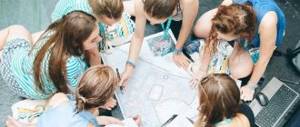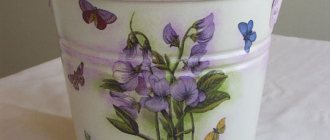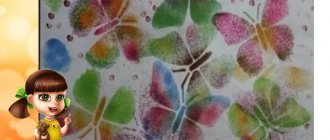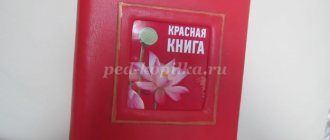Creative art project
Types of portraits: group, ceremonial, historical. Self-portrait.
Observe your peers how their facial features change depending on their mood, and make sketches. At home, make sketches from life of relatives and friends.
Assignment based on the results of the first stage: Image of a close and dear person (mother, grandmother or other relative). The use of photographs is encouraged. Technique: gouache. (Annex 1)
As a result of the project, children will learn to apply knowledge about the proportions of the human face in their works. Convey the characteristic features of your character (hairstyle, smile, decorative elements: jewelry).
Operationally - active.
Second, third and partially fourth weeks.
We analyze the work performed at the first stage of the project. What worked and what you should pay attention to.
We draw conclusions: for greater similarity, it is necessary to adhere to the laws on the proportions of a person’s face. Let's compare the proportions of an adult and a child. We find out the relative position and relationship of the parts of the head and face.
We draw the head from the front using the samples. Technique: pencil. (Appendix 2).
Let's get acquainted with a new perspective - profile. We pay attention to the features of the profile image, to the “prominent” parts of the face. We draw two profiles using knowledge of proportions. Technique: wax crayons. (Appendix 3).
We study the picturesque portraits of I.E. Repina, I.N. Kramskoy, V.A. Serova. We conclude that the most common angle when depicting a human figure is three-quarters or half-turn. We are mastering a new perspective, as the most expressive and preferred by portrait painters. (Appendix 4).
There are many ways to convey an image; in addition to painting and drawing, a portrait can be sculptural and decorative. Using a new technique - collage, we create a fantasy portrait. Collage is a type of appliqué. (Appendix 5).
Final.
End of the fourth week.
Using the acquired knowledge, create a silhouette of a warrior, reflecting belonging to a certain branch of the military and most advantageously conveying facial features. To do this, think about what kind of headgear is best to depict on the character: a sailor’s cap, a tankman’s helmet, an artilleryman’s helmet, an officer’s cap, etc. (Appendix 6).
Since the classic silhouette does not require additional drawing of details, we find out which angle should be used in the work. Analyzing the work performed during the project, we come to the conclusion that this is a profile. We make a preliminary sketch on white paper, which we later transfer to a colored background. Cut out the silhouette along the contour. We glue the tricolor onto the base. We decorate, if necessary, with inscriptions, five-pointed stars.
Pedagogical project “Fairy tales and colors” for middle group children (4-5 years old)
From the proposed understanding of children's creativity, it becomes obvious that for its development, children need to receive a variety of impressions about the surrounding life, nature, and be introduced to works of art.
Necessary conditions for the development of artistic creativity in preschool children are:
·
priority attention to children's activities - play;
·
the creative approach of the teacher to the selection of educational content based on integration, as well as to the organization of classes with children and to the use of a variety of methods and techniques in work;
·
Drawings, modeling, and appliqués made by children, both individually and collectively, should be widely used in the design of kindergarten premises;
·
wide inclusion in the pedagogical process of a variety of games, gaming techniques and gaming situations, which maximally contributes to the creation of learning motivation that is personally significant for the child, mastering the material and developing creativity in children 3-7 years old;
·
variability in everything: in the choice of lesson topics, organization of the environment (its novelty and diversity) in which work with children takes place, materials provided to them;
·
exclusion of formalism, dryness, excessive didacticism, contrary to the specifics of art and artistic creativity;
·
studying the individual characteristics of each child and, on this basis, implementing an individual approach or a person-oriented approach in teaching children visual arts and developing creativity;
·
the relationship between creativity and learning, during which children acquire the knowledge, skills and abilities necessary for creativity.
We believe that the widespread inclusion in the pedagogical process of a variety of artistic and creative activities, maximum attention and respect for the products of children's creativity, their widespread use in the lives of preschool children and in the design of the premises of a children's institution fills the lives of children with new meaning, creates an environment for them emotional well-being, causes a feeling of joy.
We proceed from the fact that engaging in various types of artistic activities creates the basis for full, meaningful communication between children and with adults, and we should strive to help them carry out such communication.
In creative activities, we see our task not so much in teaching children the fine arts, but in providing the foundations for the development of each child into a competent person capable of adequately thinking, feeling and acting in a cultural society.
Having sorted through and tested different options for the interaction of content, we came to the conclusion that it is necessary to integrate content not within the framework of one lesson with children, but within the boundaries of several lessons.
Individual final project for primary school students project (9th grade)
| MOU "LYCEUM No. 47" LENINSKY DISTRICT OF SARATOV |
| Book graphics |
| ART PROJECT WORK |
| Rabat was completed by: a student of grade 9 “A” Kalinina Daria |
| 04/22/2017 |
| ART TEACHER – Olga Valentinovna Kushnereva |
Content
Introduction —————————————————————————————p. 3
- About the graphics in general——————————————————————p. 4-6
- Book graphics——————————————————————p. 7-8
Conclusion————————————————————————————p. 9
Literature———————————————————————————-p. 10
Introduction
Graphics occupy a special place in the fine arts.
The word graphics is translated from the Greek “Grapho” - “draw”, “write”, “draw”. The main means of graphic drawing are: line, stroke, spot and contour.
In this work, I set myself the following goal: to study a new direction for me, such as book graphics.
Tasks:
— learn about the history of graphics as an art form;
- study types of graphics;
— get acquainted with graphic artists.
In the process of historical development, the following types of graphics appeared:
poster;
newspaper and magazine,
educational and design,
easel,
industrial;
computer, I will focus on book graphics, because through a book a person learns about the world. And the relevance of this topic is obvious, because... Every person perceives a book, first of all, as literature. But she's also a spectacle. Visual impressions accompany the process of perceiving a book throughout its entire duration. A book is the most beautiful flower of human culture. It combines many creative principles. The text is the soul of the book. But she has her own colors and paints, even if most often within the black and white range - the possibilities of shades and combinations here are endless. It is impossible to imagine a book without colorful illustrations, without a beautiful unusual font, without a memorable cover. All these concepts include the art of book graphics.
In the eyes of the majority of modern youth, reading literature is not an interesting and necessary activity. Therefore, through art, I would like to introduce, first of all, myself and others to reading books.
- About the graphics in general
Graphics occupy a special place in the fine arts. She has always been close to painting, appearing in individual works, along with paints and as a basis for their application. There are quite a lot of its types, well-known and not so well-known, and a large number of artists of all times and peoples turned to graphics in an effort to express themselves.
For graphics, the main visual means are a variety of lines, dots, spots, strokes and tone, which together and even separately create a coherent image. Color for this type of art is not the main thing, although it is quite acceptable. Usually, in addition to the main black, only one color is used in graphics, although sometimes (for example, in engravings) a fairly large variety of colors can be used. Due to the dominant color restraint, this type of art is sometimes also called the art of black and white.
Painting using the graphic technique
Different types of graphics and their techniques appeared gradually, not all at once. The first images, as we remember from history lessons at school, are drawings on the walls of caves and stones that remained from primitive people. Then ornaments appeared on weapons, household items and tools that came from the Neolithic and Bronze Ages. At these early stages, art also combined the function of writing - the transmission of information. Parchment scrolls, stone slabs, and clay tablets used as a source of information have survived to this day. The ancient Egyptians succeeded in combining writing and graphics - they made full use of pictograms (drawings indicating various objects, actions and subjects) to display their history.
For a long period, graphics served only to decorate objects; there were no easel graphics, and the connection with writing was preserved through the decoration of books, like everything else at that time - only handmade. China, for example, did not differentiate between drawing and calligraphy; they were considered equal and complementary. And in 868 AD There, a method was invented to increase the number of copies of a design using a cliche carved from wood. This was the beginning of woodcut - wood engraving, which appeared in Europe only in the first half of the 15th century. To this day, in Asia you can see craftsmen carving hieroglyphs or personalized seals on a wooden block.
Initially, graphics was only called writing, the art of fonts. Only at the turn of the 19th and 20th centuries did it take shape as an independent type of fine art. It is interesting to note that the modern museum classification also includes all techniques using paper and water-soluble paints (mainly watercolors, pastels and gouaches) as graphics. But here it all depends on what the artist is leaning towards - color or lines.
A Brief History of Graphics
It is believed that graphics attract with their laconicism, severity and capacity of images, combined with some uncertainty and understatement, convention, which makes the viewer’s imagination work more actively. That is why sketches, sketches, sketches - seemingly unfinished paintings, but also independent paintings - have artistic value as works of art.
Magnificent examples of graphics can be seen in Leonardo da Vinci, Michelangelo Buonarroti, Albrecht Dürer, Rembrandt van Rhein, Ivan Shishkin, Taras Shevchenko and many, many other artists also known for their painting.
Types of graphics
Line is a conventional means of representation, invented in prehistoric times. The role of line is great in all arts of all times, but it acquired special significance in the 19th – 20th centuries. The line has become, emphasized, expressive and laconic. This line can be seen in Picasso's drawings. The impetus for the emergence of the cult of the line was the admiration of Japanese engravings, which European artists became acquainted with at the end of the 19th century.
The stroke is one of the main elements of graphic drawing. A stroke is a short line made with one movement of the hand. Depending on the direction of the line, strokes can be straight, inclined, crossed and others. The difference in length, thickness, and dynamics of strokes plays a big role in the formation of the expressive features of the drawing. The technique of working with strokes is called shading. Using strokes, they convey the contour, shape, volume of figures and objects, textures and space. Strokes help create effects of light and shadow.
Spot. Closely spaced strokes are perceived by the eye as a tone spot. Tonal spots of the same strength, made with pencil or ink strokes, differ from each other in their graphic sound. In Pavel Sokolov’s illustrations for Chukovsky’s book “Captain James Cook,” parallel and intersecting strokes are used to apply the tonal spot, and in the darkest places, a solid fill of ink is used.
For graphic drawing, graphic pencils, ink, and soft drawing tools are used - charcoal, pastel, sanguine. Sanguine was introduced into use by Leonardo da Vinci. This technique makes it possible to work not only with a stroke, but also with a spot.
Color. A white sheet of paper actively participates in the creation of a graphic work. The expressiveness of the design can only be achieved by using black. That's why graphics are called the art of black and white. They also use white with gray or brown, as well as colored pencils.
In the process of historical development, types of graphics appeared: book, poster, newspaper and magazine, educational and design, easel, applied and computer.
Book graphics. In ancient handwritten books, drawings were done by hand. They were called miniature. Book graphics are not just part of publishing or a means of transmitting knowledge, they are part of culture. All elements of book design - both located inside the book and external - are a complete work of art. The role of illustrators is great. Bright phenomena in book graphics were Ivan Bilibin's illustrations for Russian fairy tales ("Vasilisa the Beautiful", "Sister Alyonushka and Brother Ivanushka" and others) and for Pushkin's fairy tales ("The Tale of the Golden Cockerel", "The Tale of Tsar Saltan") created in 1899 year. They are familiar to many generations of readers from early childhood.
Poster graphics or advertising poster is an artistic means of information for the people, used in important events taking place - Olympiads, competitions, exhibitions and others. The poster is a composition of a simple, clearly readable from a distance drawing and a short inscription, an appeal. It is customary to distinguish several main types of posters: sports, environmental, political, advertising, theatrical and entertainment and others.
Educational and design graphics. Helps in the educational process. Its various educational tables, diagrams, drawings, graphs, diagrams, plans, maps, drawings on the blackboard - the word visual aids help explain the educational material and understand it.
Industrial graphics aims to advertise goods using industrial, easel graphics: posters, greeting cards, colorful calendars, labels, postage and factory stamps, certificates of honor, invitation cards, trade leaflets and much more.
Easel graphics. Easel graphics include works that have independent meaning and form. They are not included in the context of the book, they are not placed on the streets, and they diverge in their purpose from the poster and industrial graphics. Works of easel graphics are in museum collections, private collections and are placed on walls and public and residential interiors. The main types of easel graphics are easel drawing and easel sheet of printed graphics.
Computer graphics is a new type of graphics. Artists create compositions from complex intersecting lines, volumetric elements, patterns, color spots on the display screen, and then print the resulting images on a printer. The ability of graphics to quickly respond to current events, to express the feelings and thoughts of the artist, and the development of technology create the conditions for the emergence of new types of graphics.
II. Book graphics
A book is one of the most important spiritual needs of the modern world. It organically combines the work of artists and publishing workers. The book artist has the complex and responsible task of embodying the ideological and artistic concept, the content of the literary text, and creating the artistic and decorative appearance of the book through the means of fine art. The uniqueness of the illustration is that it is not independent in relation to the plot. The artist, in a way, helps the author, makes his images and ideas visible.
Book graphics have two main tasks - book design and illustration. The design of the book includes its decorative outfit, hand-drawn fonts, and compositional structure of the text. Illustrating a book solves the problem of revealing a literary image with the help of drawings and illustrations of various types. In a well-made book, it is impossible to determine where the design begins and where the illustration begins. The illustration in the book, with all the depth of the imagery, should also be an element of decoration of the book, in harmony with the typesetting and paper. One of the brightest representatives of Russian art, graphic artist Vladimir Favorsky (Lament of Yaroslavna. Illustration for the book “The Tale of Igor’s Campaign,” 1950) created many brilliant books with magnificent illustrations. The smallest decorative elements, deep meaning of images, psychologically acute illustrations are in harmony with the text and decorative appearance of the book.
There are different types of literature and types of books. Depending on the purpose of the book, its circulation, format, design and illustrations will depend. For example, fiction, children's books, scientific and technical literature, unique books, and so on. The book includes several elements in which the artist plays a leading role.
The cover is the covering of the book that encloses the book. Its solution should attract attention and contain basic information (author and title of the book). The artist strives to make the cover clear, decorative, and give it a beautiful appearance. At the same time, the cover should reveal the main meaning of the book, its exact characteristics, style and figurative structure. Sometimes a dust jacket made of paper, more elegant and decorative, is put on a simple cover. The title page is the right half of the first spread of the book. It contains complex fonts that explain the title. And if an illustration is placed on the left half of the first spread, then such a page is called a frontispiece. Illustration - drawings that reveal the literary text, subordinate to the content and style of the literary work, decorating the book. There are also small drawings and decorations in the text of the book: headband (I.Ya. Bilibin. Screensaver for the magazine “Golden Fleece”. 1906), ending (I.Ya. Bilibin. Ending to “The Tale of the Golden Cockerel” by A.S. Pushkin . 1907), initial (letter letter) (I.Ya. Bilibin. Drop letters for the magazine “Golden Fleece”. 1906).
Illustrating and designing fiction gives the artist the opportunity to more diversify the creative process. He chooses such an author and such a work that is close to him in concept and style. Thoughtful reading of the text is one of the initial stages. Carrying out his work, the artist carefully studies the era, the art style of that time, types of people, furnishings, clothing, ornaments and fonts. Having determined the moments in the book that should be focused on, the artist considers what means of fine art to highlight these moments, finds the composition of the book and makes a layout. The original illustrations are made by the artist in a variety of graphic materials. Printing forms are prepared from them. But by illustrating the text, the artist retains his individuality and creative style. All visual elements in the book are directly related to the font. An artist must not only know fonts and be able to use them, but also be able to modify existing ones and create new ones that correspond to his design and style of the work.
The history of the book is closely connected with the development of fine arts and graphics. Artists play a leading role in the creation of a handwritten book. They were the creators of fonts, decorations, and illustrations. The drawing intended for the book has been known in China since the 4th century. In Russia, the first handwritten books with images date back to the 10th century. With the invention of printing in the middle of the 15th century and the widespread distribution of books, the role of the artist increasingly increased and his tasks became more profound. The work of Russian artists of the turn of the 19th and 20th centuries - A. Benois, I. Bilibin and other members of the World of Art association, who rallied around the magazine of the same name, is distinguished by high skill. In the twentieth century, the golden fund of book graphics includes the works of V. Favorsky. Among illustrators of children's literature, a significant place is occupied by the works of Y. Vasnetsov (“Whale Fish”), V. Konashevich (“The boat floats, floats and others”).
Conclusion
Book graphics reflect our reality through figurative, visual reproduction of its forms, convey the appearance of objects and phenomena of the surrounding world, the whole variety of events perceived by vision. In turn, book graphics are an integral, integral part of a book publication. The book includes literature, graphics, type art and printing art. Book artists develop the design of the book, the type of publication, its decorative design, and the illustrative cycle. The design of a book is always traditional: book block, cover, binding, dust jacket, flyleaf, title page, titles, fonts, illustrations. All these elements obey the laws of composition and are combined into a single ensemble.
Modern book graphic artists often create very beautiful and high-quality illustrations, but now there are no such talents that can stand on a par with the names of Soviet classic book artists creating for children - Suteev, Charushin, Tokmakov, Miturich, Konashevich.
Modern book graphics is a world without strong boundaries, in which a stone wall can turn into the depth of the sky, in which distant stars will shine. But in all its transformations, this world remains cozy and kind.
I believe that new forms of literary text today, in the 21st century, are capable of giving rise to a new form of illustration. Book graphics do not stand still; they develop along with the book. Creating e-books entails the creation of computer, visual, animation and audio illustrations. It is impossible to say for sure whether this is good or bad, or whether they will ever be able to compete with the classic design of the book. But the main thing is that book graphics have a future. And modern artists are able to prove this.
Literature
- Magazine “Young Artist No. 5 1983”
- Educational and methodological newspaper for teachers No. 13 2010
- Educational drawing. Kosterin. 2010
- Fine arts “A Brief Dictionary” by N.M. Sokolnikov.
Applications
- Graphic drawings
- Fiction
Review
for project work in Art
students of grade 9 "A"
Kalinina Daria
on the topic: “Book graphics”
In this work, the author examines issues related to the study of book graphics.
For this purpose, Daria Kalinina collected and systematized material by type of graphics. Dasha, throughout her work, draws parallels between art and literature.
This work includes two sections: the theoretical - abstract part and the practical part - drawing a picture, searching for the necessary books in the library, where we will see visual examples of book graphics.
This project can be useful for school students who want to try their hand at creating similar projects, as well as for use as visual material when studying the topic “Book Graphics”.
The practical part of the work clearly demonstrates the author’s competence in the issue under study. In general, the work deserves a positive assessment.





